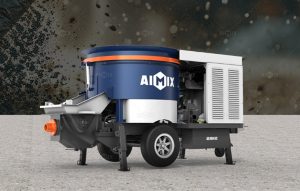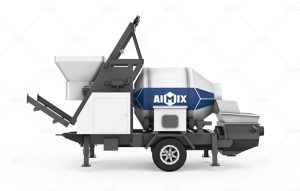When working on bridge construction projects with limited space, particularly those confined to areas under 10 meters in width, choosing the right small concrete pump or concrete mixer with pump for sale becomes a critical decision that directly impacts project efficiency, safety, and concrete placement quality. Unlike open construction sites, narrow bridge locations present unique challenges including restricted movement, limited access for large equipment, and precise concrete placement requirements over waterways or existing infrastructure. The ideal concrete mixer with pump for sale for such constrained environments must balance compact dimensions with sufficient pumping capacity, while also offering maneuverability features that allow operation within tight working zones. This comprehensive guide examines the various size options available in small concrete pump and combined mixer-pump units, analyzing their suitability for narrow bridge construction based on key parameters such as physical dimensions, output capacity, boom reach, and mobility characteristics to help contractors make informed equipment selections.
Understanding Space Constraints in Narrow Bridge Construction
Bridge construction projects with width limitations under 10 meters demand specialized equipment configurations that traditional concrete mixer with pump for sale models often cannot accommodate. The working area typically includes not just the bridge deck itself but also the approach areas where the small concrete pump must position itself while maintaining stability during concrete placement. Standard truck-mounted concrete pumps with full-size mixers often require 12-15 meters of operating width when accounting for outrigger deployment and material delivery vehicle access, making them impractical for such confined sites. This limitation has driven manufacturers to develop compact versions of concrete mixer with pump for sale units specifically designed for restricted spaces, featuring narrower chassis, reduced outrigger spans, and sometimes even zero-tail-swing designs that eliminate rear-end equipment protrusion during operation. When evaluating options, contractors must consider not just the static width of the equipment but also its dynamic operational footprint—the total space required when accounting for all moving parts during pumping cycles.
The vertical clearance represents another critical dimension in bridge construction, particularly when working under existing structures or in areas with overhead obstructions. Many small concrete pump models designed for narrow spaces feature low-profile designs with heights under 3.5 meters when fully assembled, allowing them to pass under low bridges or through tunnels to reach the work site. Some advanced concrete mixer with pump for sale units incorporate foldable or telescopic masts that minimize transport height while still providing adequate vertical reach for bridge deck placements. The combination of restricted width and height requirements makes certain configurations particularly suitable for confined bridge projects, including trailer-mounted pumps with detached mixers, compact truck-mounted combos with short wheelbases, and specialized mini units that can be positioned on completed bridge sections for incremental placements.
Compact Mixer-Pump Combinations Under 3 Meters Width
For the most severely restricted bridge sites where operating width must be kept to an absolute minimum, several concrete mixer with pump for sale models are available with overall widths under 3 meters, making them ideal for narrow construction zones. These ultra-compact units typically combine a small-capacity mixer (0.5-1 cubic meter batch size) with a piston pump capable of outputs between 20-40 cubic meters per hour—sufficient for most bridge construction applications where placement rates are moderated by forming and reinforcement activities. The German-made Putzmeister M 740 D represents a prime example of this category, featuring a 2.8-meter width when configured for narrow access work, with folding outriggers that require less than 5 meters of side clearance during operation. Similarly, the Schwing SBP 500 trailer-mounted small concrete pump offers a 2.9-meter width profile while delivering 30 m³/h pumping capacity, making it suitable for bridge projects where space constraints prevent the use of larger equipment.
These narrow-width concrete mixer with pump for sale units achieve their compact dimensions through several design innovations. Radial piston pumps replace traditional axial designs to save space while maintaining pressure capabilities up to 70 bar for vertical bridge pier placements. The mixer components are often positioned directly over the pump unit in a vertical integration that minimizes the machine’s footprint without sacrificing batch consistency. Outrigger systems on these compact models frequently employ telescoping or folding designs that extend only minimally beyond the chassis width when deployed, with some versions featuring automatic pressure-sensing stabilizers that adjust to uneven ground conditions common near bridge abutments. When selecting among these ultra-narrow options, contractors should verify not just the equipment’s static dimensions but also its operational envelope—particularly the turning radius required to position the unit on site, which can range from 5-8 meters for the most maneuverable small concrete pump configurations.
Mid-Size Options (3-5 Meter Width) for Balanced Performance
Bridge construction projects that can accommodate slightly wider equipment—typically in the 3-5 meter range—gain access to concrete mixer with pump for sale models offering enhanced capabilities while still maintaining reasonable maneuverability. This category includes numerous truck-mounted combination units that provide concrete mixing and pumping in a single integrated package, eliminating the need for separate mixer trucks in space-constrained areas. The Sany SY9300S truck-mounted small concrete pump, for instance, combines a 6 m³ mixer with a 60 m³/h pump in a package just 4.2 meters wide with outriggers retracted, making it suitable for many medium-width bridge projects. These mid-size options typically offer improved concrete placement flexibility through articulated booms with 3-4 sections providing reaches between 20-32 meters—sufficient for most small to medium span bridge constructions without requiring frequent equipment repositioning.
The advantages of these slightly larger concrete mixer with pump for sale units become apparent when considering production efficiency on bridge projects. The increased mixer capacity (typically 3-6 m³) allows for continuous pouring of larger bridge segments without constant reloading, while the enhanced pump capacity (40-80 m³/h) maintains placement rates that keep pace with forming crews. Many models in this category feature advanced stability systems that enable safe operation on the uneven ground commonly encountered near bridge approaches, with some incorporating automatic load-sensing outriggers that adjust extension based on real-time weight distribution—a critical safety feature when working near bridge edges or waterways. The pumping systems on these mid-size units often include pressure-compensating controls that automatically adjust output to maintain consistent concrete flow regardless of vertical or horizontal placement distance, ensuring uniform quality throughout bridge deck placements.
Specialized Solutions for Challenging Bridge Geometries
Certain narrow bridge projects present unique geometry challenges that require customized small concrete pump solutions beyond standard compact models. Curved bridge alignments, for example, may necessitate equipment with exceptional articulation capabilities to follow the deck profile without requiring multiple setup positions. Several manufacturers offer concrete mixer with pump for sale units with articulating chassis or all-wheel steering that can navigate tight curves while maintaining pumping operations. The Zoomlion ZP3810 features a unique three-segment boom with 220-degree rotation capability, allowing concrete placement along curved bridge decks from a single setup point—particularly valuable when working within strict width limitations.
For bridge projects involving significant vertical elements such as high piers or abutments, the selection criteria for a small concrete pump shifts to emphasize vertical reach capability within the width constraints. Several compact trailer-mounted pumps combine narrow footprints (under 3.5 meters) with impressive vertical pumping heights exceeding 100 meters through high-pressure piston pump systems. The Mecbo Tough 50 exemplifies this category, packing a 50 m³/h pumping capacity into a 3.2-meter-wide package capable of vertical placements up to 150 meters—ideal for tall bridge piers where conventional equipment would be too large for the confined work area at ground level. These specialized units often incorporate remote-controlled placement systems that allow precise concrete deposition from safe vantage points, reducing the need for workers to position themselves in hazardous areas near the bridge edges.
Power System Considerations for Remote Bridge Sites
The power source for a concrete mixer with pump for sale unit becomes particularly important when working on narrow bridge projects in remote locations where electrical infrastructure may be limited. Diesel-powered small concrete pump models dominate this application space due to their self-contained operation, with modern units featuring Tier 4 Final or equivalent emissions-compliant engines that minimize environmental impact while delivering reliable performance. Engine sizing requires careful consideration—units between 100-200 horsepower typically provide the best balance between compact dimensions and adequate power for simultaneous mixing and pumping operations. Some advanced models incorporate energy recovery systems that capture hydraulic energy during deceleration phases, improving fuel efficiency by 15-20%—a significant advantage on extended bridge projects where equipment may operate continuously for hours.
For bridge projects with strict emissions requirements or indoor components (such as approach tunnels), electric-powered concrete mixer with pump for sale units are available in compact configurations. These models typically require a 380V power supply but eliminate exhaust emissions at the point of use—an important consideration for urban bridge projects or environmentally sensitive areas. The Cifa CS6 electric small concrete pump represents a leading option in this category, offering 45 m³/h pumping capacity in a 3.1-meter-wide package ideal for confined bridge sites with access to grid power. Hybrid power systems are also emerging in the market, combining the flexibility of diesel power with the clean operation of electric drive for situations where the equipment must transition between powered and unpowered bridge sections during a single placement operation.
Material Handling and Supply Logistics in Narrow Sites
The selection of an appropriately sized concrete mixer with pump for sale unit must account for material supply logistics in the constrained bridge construction environment. Integrated combination units that include both mixing and pumping functions offer distinct advantages in narrow sites by eliminating the need for separate mixer trucks to maneuver in tight spaces. These systems typically feature aggregate hoppers with capacities between 3-6 cubic meters and cement silos holding 20-40 tons, allowing for continuous operation without frequent material replenishment. The Aimix ABJZ30C exemplifies this approach, combining a 0.5 m³ twin-shaft mixer with a 30 m³/h pump in a compact trailer-mounted package just 2.5 meters wide—capable of operating in bridge construction zones where traditional ready-mix trucks cannot access.
For projects where local material batching isn’t feasible, contractors may opt for a standalone small concrete pump fed by conveyor systems or specialized narrow-access mixer trucks. In these configurations, the pump’s receiving hopper design becomes critical—models with low-profile, wide-opening hoppers accommodate various delivery methods while minimizing spillage in the confined work area. Some pumps designed for narrow bridge work incorporate flexible receiving conveyors that can extend to meet material delivery vehicles positioned outside the immediate construction zone, reducing congestion in the critical work area. The pump’s ability to handle different concrete consistencies also warrants consideration, as bridge mixes often incorporate specific slump requirements for proper placement in heavily reinforced sections—look for units with variable displacement piston pumps that can adjust output pressure to accommodate mix variations without clogging.
Matching Equipment Dimensions to Project Requirements
Selecting the optimal concrete mixer with pump for sale for narrow bridge construction under 10 meters width requires careful analysis of both the physical constraints and the technical demands of concrete placement in confined conditions. Ultra-compact units under 3 meters width provide access to the most severely restricted sites but may sacrifice some production capacity, while mid-size options in the 3-5 meter range offer enhanced performance while still accommodating many narrow bridge geometries. Specialized features such as articulating booms, high-pressure pumping systems, and innovative outrigger designs extend the capabilities of small concrete pump equipment in challenging bridge applications. By carefully matching equipment specifications to the specific spatial and technical requirements of each bridge project, contractors can ensure efficient, safe concrete placement that meets quality standards while working within strict width limitations. The market offers a diverse range of concrete mixer with pump for sale configurations to meet these needs, allowing well-informed buyers to select equipment that optimizes productivity without compromising on space constraints or placement precision.


Leave a Reply